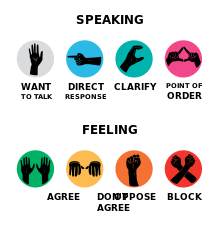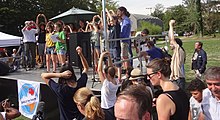Occupy movement hand signals

The Occupy movement hand signals are a group of hand signals used by Occupy movement protesters to negotiate a consensus.[1][2][3] The signals have been equated with other hand languages used by soldiers, cliques, or even Wall Street traders.[4] Hand signals are used instead of conventional audible signals, like applause, shouts, or booing, because they do not interrupt the speaker using the human microphone, a system where the front of the crowd repeats the speaker so that the content can be heard at the back of the crowd. Between sharing of information on Facebook, Twitter, and other news reports, the hand signals have become common at other Occupy movement protest locations.[5][6][7][8] Some protesters go to neighboring groups to assist in teaching the hand signals along with other general cooperation.[9] There are YouTube videos showing the hand signals, though the signals are not universal at all locations.[10][11]
Example signals[]

- Up twinkles or simply twinkles are both hands raised with fingers pointing up and being wiggled. Twinkles indicates agreement with what is being said. This handsignal was borrowed from the Green Party, who borrowed it from the ASL word for applause.
- Flat hands means that you are not sure, not for, or not against. One may be asked to clarify one's position.
- Down twinkles are arms raised but showing the back of both hands with fingers pointing down and wiggling. Down twinkles indicate disagreement with what is being said. One will be asked by the facilitator to clarify one's objection. In Occupy Boston (possibly other sites), down twinkles go by the alternate name of "squid fingers".[12]
- Thumbs up, neutral, or thumbs down—Some locations use the thumbs signal, to show approval, neutrality, or disapproval similar to the Pollice verso of Roman gladiators.[10]
- Direct response is both hands moving alternately front to back on each side of the head and directed at an individual. Direct response indicates that critical information was missing from something that was just said.
- Clarifying question is a single hand formed in the shape of a C. Clarifying question means that someone has a question that needs to be answered before that person can vote on an issue.
- Point of process is a triangle formed by two hands with the index fingers touching and the thumbs touching to form a triangle shape. Point of process means that the conversation has strayed from the original topic.
- Wrap it up is both hands moved in a circular motion about each other. It means that the speaker should make his or her points and finish speaking.
- Raise the roof is both hands with palms facing up being moved up and down above shoulder level. Raise the roof means to speak up.
- Hard block is holding arms up and crossed. This indicates a firm opposition to the proposal, a break from the consensus that cannot be supported by this individual.
Twinkles and down twinkles are referred to as a "temperature check". They indicate if a group is getting close to consensus. Twinkles are also known as "sparkle" or "jazz hands" or spirit fingers.[13]
Origins[]
In addition to commonalities with various sign languages, and cultural gestures, these or similar hand signals have been used by other groups and events prior to the Occupy Wall Street protests. These include:
- Camp for Climate Action
- The Woodcraft Folk
- Direct Action Network[14]
- The 15-M Movement beginning in Spain 2011[15]
- UK Uncut[16]
- Civil rights movement[17]
- Quaker meetings[16]
- Global Justice Movement[18]
Influence[]

Some followers of agile software development processes have drawn on the Occupy movement's hand signs in an attempt to improve communication during meetings, notably the UK's Government Digital Service.[19]
After the Occupy movements, these hand signals were used by other social movements such as the School strike for the climate, and Extinction Rebellion.[20]
See also[]
- Consensus decision-making – hand signals
- Hand signaling (open outcry)
- Human microphone
- Jazz hands
- Thames Valley Climate Action
References[]
- ^ Occupy Portland - DownTwinkles, retrieved 2020-05-02
- ^ "The Colbert Report". Comedy Central.
- ^ Erin Alberty, “Occupy SLC protesters vilify elite, camp with destitute” The Salt Lake Tribune, October 28, 2011
- ^ "Water Cooler Wars: Occupy hand signals » Anderson Independent Mail". Independentmail.com. Archived from the original on 2014-01-11. Retrieved 2011-11-17.
- ^ DOUG WARD (2011-10-17). "Human mike, hand signals unify Occupy Vancouver crowd". Vancouver: Vancouversun.com. Retrieved 2011-11-17.
- ^ Andrew, Susan. "Checking out Occupy Asheville's 'General Assembly' | Mountain Xpress | Asheville, NC". Mountainx.com. Retrieved 2011-11-17.
- ^ Poisson, Jayme (2011-10-22). "Hands up, Toronto". thestar.com. Retrieved 2011-11-17.
- ^ "The Literature Of Occupy Wall Street | The Prague Post Blogs". Praguepost.com. 2011-11-04. Retrieved 2011-11-17.
- ^ Woolfolk, Daniel (2011-11-04). "Occupy Oceanside to Send Delegates to Occupy North County - Camp Pendleton, CA Patch". Camppendleton.patch.com. Archived from the original on 2012-05-15. Retrieved 2011-11-17.
- ^ a b ekai (2011-10-05). "Consensus Decision-Making Hand Signals Explained at #OccupySF". YouTube. Retrieved 2011-11-17.
- ^ KimBoekbinder. "Occupy Wall Street - Hand Signals". YouTube. Retrieved 2011-11-17.
- ^ "Reaching Consensus". October 17, 2011. Retrieved May 18, 2012.
- ^ Chris Barton "'Occupy Auckland' protest speaks with many voices", New Zealand Herald, October 29, 2011
- ^ Polletta, Francesca (May 2, 2004). Freedom Is an Endless Meeting: Democracy in American Social Movements. University of Chicago Press. ISBN 9780226674490 – via Google Books.
- ^ "Signos asamblearios". 15Mpedia. Retrieved 2016-04-20.
- ^ a b Howker, Ed (2011-04-10). "Hands up to protest". Guardian Online. London. Retrieved 22 November 2011.
- ^ Schwartz, Mattathias (2011-11-28). "Pre-Occupied. The origins and future of Occupy Wall Street". The New Yorker. Retrieved 2011-11-22.
- ^ Ramírez-Blanco, Julia (2018). Artistic Utopias of Revolt. New York: Palgrave. pp. 72–73. ISBN 978-3-319-71422-6.
- ^ "Platform as a Service team takes even-handed approach to meetings". GOV.UK GDS. 7 October 2016.
- ^ NVDA Handouts, Rising Up! (page visited on 4 October 2019).
- Occupy Wall Street
- Occupy movement in the United States
- Hand gestures